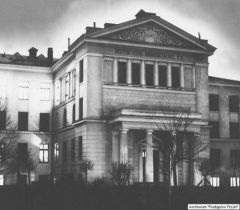History of the Faculty
Physics and astronomy have been present at the University of Warsaw ever since it was established in 1816. The first professor of physics was Karol Skrodzki (1787-1832), while Franciszek Armiński (1789-1848) was the first astronomer and founder of the Astronomical Observatory. After World War I, Stefan Pieńkowski (1883-1953) created at 69, Hoża St. a center of research in atomic and molecular optics of worldwide significance. During the 1930s about 15 percent of all papers on luminescence originated from the research of the Hoża physicists. The first ever Congress on Luminescence took place here in May, 1936. Theoretical physics was led by Czesław Białobrzeski (1878-1953), known for his 1913 paper in which he introduced radiation pressure in the internal structure of the stars. In 1938 he organized the „New Theories in Physics” conference, famous for its role in the development of quantum physics.
After World War II, the scope of research began to grow, encompassing solid state physics (Leonard Sosnowski (1911-1986)), the physics of nuclei and elementary particles (Marian Danysz (1909-1983), Jerzy Pniewski (1913-1989), and Andrzej Sołtan (1897-1959)), later also studies in solid state via nuclear methods, biophysics, and medical physics. Hypernuclear physics originated at Hoża with the discoveries of the first hypernucleus (1952), and the first double hypernucleus (1962). More recently (2002), the group led by Marek Pfuetzner discovered, in collaboration with the French group at GANIL, a new type of radioactivity: the emission of two protons. Important results were obtained in the research of semimagnetic semiconductors (Jan Gaj (1943-2011)), in ultrashort laser pulses (group of Czesław Radzewicz), and in design and synthesis of RNA termini for anti-cancer vaccination (a group led by Edward Darżynkiewicz).
Theoretical physics in the post-war period was first developed by Wojciech Rubinowicz (1889-1974), renowned for his 1918 paper on the selection rules in atomic physics. It began to flourish in the 1950s, when Leopold Infeld (1898-1968), famous for his papers co-authored with Albert Einstein, proceeded to create a separate Institute of Theoretical Physics, engaged in a wide range of research topics. Along with the classical areas of mechanics, thermodynamics, electrodynamics, and relativity theory, this included the theory of the atomic nuclei, of elementary particles, solid state theory, statistical physics, and mathematical methods in physics. Most recent results concern the physics of supersymmetric particles (group of Stefan Pokorski)and formulation of a quantum model of the gravitating scalar field (Jerzy Lewandowski et al.).
Our astronomy group (OGLE project) led by Andrzej Udalski developed a novel method of simultaneous measurements of brightness of thousands of stars. The studies performed in the University of Warsaw Observatory at Las Campanas (Chile) resulted in the discovery of the first transiting and microlensing extrasolar planets.
Up to 1926, physics and astronomy formed part of the Philosophical Faculty; later on, until 1949, of the Faculty of Mathematics and Natural Science. For the next three years, physicists were part of the Faculty of Mathematics, Physics and Chemistry; and for the following sixteen years, of the Faculty of Mathematics and Physics. The Faculty of Physics exists since 1969.






